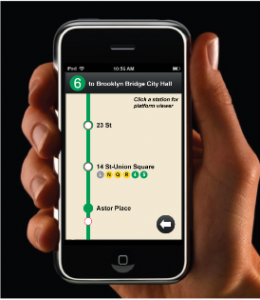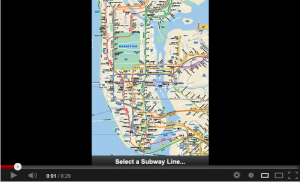Group Members: Andrew Adams, Tim Durland, Andrew Ng
Prof. Natalia Sucre
LIB 1201 – 3950
Date: December 17th, 2012
Group Documentation for Research tool
The group project, NYC Metro Live App, is a mobile application designed to allow commuters to view current train locations and platform conditions within the New York City (NYC) subway system. It also includes tools for locating stations, planning trips, and receiving alerts from the Metropolitan Transportation Authority (MTA). (See Image 1).
Image 1

Image compiled with images from HuffingtonPost.com and Tim Durland.
This type of research method used in this project was library, online, and database research. It included newspaper articles, blogs, an online case study, websites for existing apps for MTA. The data for this is primarily qualitative. A total of seventeen sources were selected most of the information was directly related to NYC subway system. Articles from other metropolitan cities including San Francisco and Tokyo were also chosen to get a feel for existing apps in these cities. Criteria for analysis of sources were based on characteristics of relevance, scope, and currency. Currency was determined based on publication date and whether or not the site had information on how often it was updated. Relevance was determined based on the title of the article, the authorship, and content. Scope was determined based on the elements of the content such as maps, artwork, tracking, and information on schedules.
The data selection process began with library, and database research. Library and database research helped with initial reading that led to the narrowing of our topic. However the samples chosen for our research was done via Google search. The search terms used: “Subway”, “App”, “NYC subway map”, “mobile”, “centralized traffic control new york”, “computer controlled subway tracking”,“subway tracking”, “next train”, “Alex Morgan Bell”, “subway application”, and “map”. These yielded thousands of search results. However, articles were purposefully chosen based on title and relevance, currency. Next a listing of the sources was compiled in a works cited page. The articles chosen were analyzed for content and summarized. The information garnered was instrumental in helping to identify a need for the Metro Live App, perspective audience and design and implementation of the Metro Live App.
From start to finish, the time for this project was three week—December 3—21, 2012. In order to ensure that it was finished in a timely manner, a work plan was devised. Tasks were assigned according to the strength of individual team members. Communication was conducted through email, shared information via Google documents, and group meetings. Finally, a video was produced to demonstrate how the Metro Live App works. (See Image 2). The main findings of this project were presented in Google presentation.
Image 2 
Video Image Produced by Tim Durland.
The Google presentation consists of ten slides. The first slide is an overview of the proposal. The second is a summary of the research process. The third slide shows how the research informed the project. The fourth slide is a description of the research and scientific applications. The fifth slide details the main features of the research tool. The sixth slide is about existing apps. The seventh slide expresses the uniqueness of the Metro Live App. The eighth illustrates how the Metro Live App operates. The ninth slide explores limitation of the Metro Live App. The tenth slide examines the limitations of the Research.
Research can be time-consuming. Consequently, one of the biggest limitations associated with this project was the time constraints. The short duration of this project resulted in a small sample of sources. Another limitation was the method of research. Most of the research was done online, using existing information to guide the research. As a result, we missed an opportunity to conduct a study, base on firsthand information such as interviews or surveys.
For future project of this nature the principle investigator of this project would recommend a case study and a minimum of at least 3—6 months for the research process. A case study would allow for data collection through person contact as well as through the literature. It would provide a forum for greater evaluation and assessment of data. Moreover, information gather from the sample collected of the principle stakeholders (e.g. MTA official and commuters) could be used to better inform the design of the NYC Metro Live App, and the final report could be comprised of quantitative as well as qualitative data.



